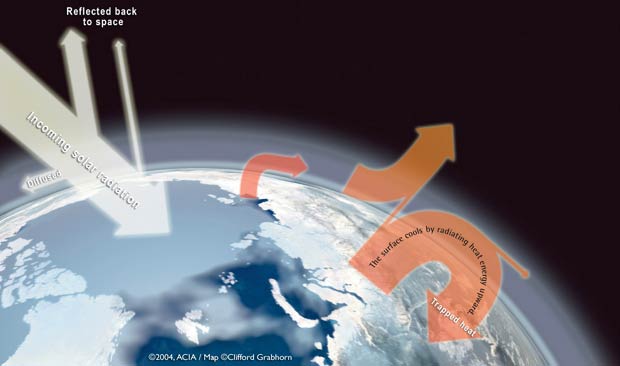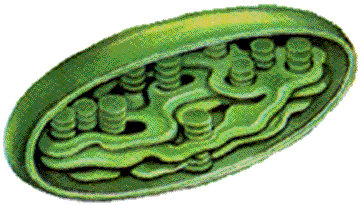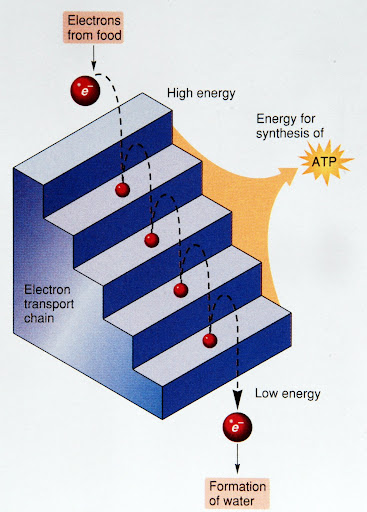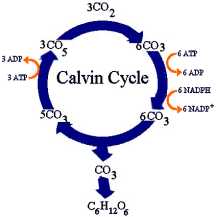- Carbon cycle: process which carbon moves from inorganic to organic compounds and back

- Photosynthesis converts inorganic carbon dioxide to organic compounds
- Consumers obtain organic compounds by eating producers
- Cellular respiration returns carbon dioxide to atmosphere
- Photosynthetic organisms produce 160 billion metric tons per year
- Carbon dioxiode makes sugars in photosynthesis
- Cellular respiration gives off carbon dioxide as waste
- Carbon dioxide in atmosphere traps heat

- This keeps climate warm for living things
- Atmospheric carbon dioxide has been rising
Thursday, November 13, 2008
Chapter 8.4
Tuesday, November 11, 2008
Chapter 8.3
- Calvin cycle produces sugar and other organic compounds used as fuel
- Starting material is regenerated each cycle
- Starting material is RuBP, a sugar with five carbons
- Inputs of cycle: carbon dioxide, ATP, and NADPH
- Outputs: small energy-rich sugar molecule called G3P
- G3P: Raw material to make glucose and other organic molecules
- Light reactions take place in thylakoid membranes
- Convert light energy to chemical energy of ATP and NADPH
- Light reactions use water in equation and produce oxygen
- Calvin cycle takes place in stroma
- Uses ATP and NADPH to convert carbon dioxide into sugar
- Photosynhesis is first step in flow of energy through ecosystem
- Chemical energy passed from producers to consumers
- Photosynthesis is ultimate source of food and oxygen
Concept Check 8.3
1) What are the inputs and outputs of the Calvin cycle?
The inputs are carbon dioxide, ATP, and NADPH. The output is G3P.
2) Which stage of photosynthesis uses each reactant from the overall photosynthesis equation? Which stage generates each product from the overall photosynthesis equation?
The light reactions use water as a reactant and produce oxygen. The Calvin cycle uses carbon dioxide as a reactant and produces sugar.
3) Why is the Calvin cycle called a cycle?
The Calvin cycle is a cycle because the starting material, RuBP, is regenerated.
4) What molecule is the direct product of photosynthesis? How is that molecule then used by plant cells?
The direct product of photosynthesis is a small sugar molecule called G3P. With G3P, plant cells can make glucose or any other organic molecule it needs.
Monday, November 10, 2008
Chapter 8.2
- Sunlight is a form of electromagnetic energy
- Electromagnetic energy travels in waves

- Wavelength: distance between two adjacent waves
Visible light: wavelengths you see as different colors - Shorter wavelengths have more energy than longer wavelengths
- Wavelengths shorter than visible light have enough energy to damage organic molecules
- Pigments: chemical compounds that give a substance color
- Light waves are either absorbed, transmitted, or reflected
- Chloroplast pigments absorb blue-violet and red-orange light
- Absorbed light energy converted into chemical energy
- Green light is transmited (passes through leaf) or reflected which is why leaves look green
- In thylakoid membrane, clusters called photosystems
- Photosystems contain few hundred pigment molecules
- Clusters act as a light-gathering panel
- When pigment molecule absorbs light energy, electrons gain energy
- Excited electron is very unstable and passes energy to neighboring molecule
- Excited electron in receiver than passes energy to next pigment molecule
- Energy jumps from molecule to molecule until it reaches reaction center of photosystem
- Reaction center consists of chlorophyll a molecule next to primary electron acceptor
- Primary electron acceptor traps excited electron from chlorophyll a
- Other molecules use energy to make ATP and NADPH

- First photosystem traps light energy and transfers electrons to electron transport chain
- Splits water molecules that releases H+ ions and oxygen as a waste product
- Electron transport chain connecting two photosystems releases energy to make ATP
- Mechanism similar to ATP production in cellular respiration
- H+ ions pumped across thlakoid membrane
- Light-excited electrons from photosynthesis travel down chain
- Second photosystem uses excited electrons and H+ ions to make NADPH
- Calvin cycle uses ATP and NADPH produced by light reactions
Vocabulary
Sunday, November 9, 2008
Chapter 8.1
- Photosynthesis takes place in chloroplast

- Green parts of plants carry out photosynthesis
- Chloroplasts are concentrated in the cells of the mesophyll
- The mesophyll is the inner layer of tissue
- Tiny pores called stomata are found on surface of leave
- Carbon dioxide enters and oxygen exits through stomata
- Veins carry water and nutrients from roots to leaves
- Also deliver organic molecules from leaves to other parts
- Chloroplast has inner and outer membrane
- Inner membrane encloses thick fluid called stroma
- Stroma has disk-shaped sacs called thylakoids
- Thylakods organize chemical reactions of photosynthesis
- In photosynthesis, electrons boosted "uphill" by light energy
- Excited electrons plus carbon dioxide and hydrogen ions produce sugar molecules

- 6CO2 + 6H2O --> C6H12O6 + 6O2 = equation for photosynthesis
- Two main stages: light reactions and the Calvin cycle
- Light reactions convert sunlight energy to chemical energy
- Reactions depend on molecules built into thylakoid membranes
- Chlorophyll captures light energy
- Chloroplasts use energy to remove electrons from water
- Splits water into oxygen and hydrogen ions
- Oxygen is "waste product"
- Electrons + hydrogen ions = NADPH
- Light energy also generates ATP
- Overall result: NADPH and ATP
- Calvin cycle makes sugar from atoms in CO2, hydrogen ions, and high-energy electrons carried by NADPH
- Enzymes for Calvin cycle located outside thylakoids and dissolved in stroma
- ATP provides energy to make sugar
- Calvin cycle does not directly require light
- Requires two inputs from light reactions: ATP and NADPH
Tuesday, November 4, 2008
Chapter 7.6 Summary
- When you sprint, lungs and bloodstream can't supply oxygen fast enough to make ATP
Instead, muscle cells use fermentation - Fermentation: making ATP without oxygen
- While cellular respiration still continues, fermentation is main source of ATP

- Fermentation makes ATP from glycolysis
- Yields 2 ATP per glucose molecule
- Fermentation produces lactic acid
- Build up of lactic acid contributes to fatigue after exercise
- Yeast also ferments of sugar and other foods
- Instead of lactic acid, produces alcohol
- Fermentation of fungi and bacteria turn milk into cheese; soybeans into soy sauce; cabbage into sauerkraut
Concept Check 7.6
1) How is fermentation different from cellular respiration?
Fermentation produces ATP without oxygen and only produces 2 ATP per glucose molecule.
2) Describe one example of how fermentation in microorganisms produces human foods
The fermentation of fungi and bacteria is how milk is turned into cheese.
3) What is the waste product of fermentation in your muscle cells?
The waste product of fermentation in our muscle cells is lactic acid.
Chapter 7.5 Summary

- Mitochondria's structure key for cellular respiration
- Inner membrane is highly folded to give more room and maximize ATP production
- Metabolism: all a cell's chemical processes
- Cellular respiration consists of a series of reactions - referred to as a metabolic pathway
- Enzymes catalyze each reaction
- Three main stages of cellular respiration: glycolosis, Krebs cycle, electron transport chain
- Glycolysis: breaking down a glucose molecule
- Takes place in the cytoplasm outside the mitochondria
- Glucose is split in two, each molecule with three carbons and one phosphate group
- Each 3-carb molecule transfers electrons and H ions to NAD+
- NAD+ --> 2 electrons + H ion --> NADH
- Four new ATP molecules produced - net gain of 2 ATP molecules
- 3-carb molecule become pyruvic acid
- Krebs cycle takes place within fluid matrix of inner membrane
- Finishes breaking down pyruvic acid into carbon dioxide
- Glycolysis produces 2 pyruvic acid molecules
- Pyruvic acid loses one CO2 molecule and becomes acetyl CoA
- Acetyl CoA enters Krebs cycle and joins a four-carbon acceptor molecule
- Reactions produce 2 CO2 molecules and 2 ATP (one per acetyl CoA)
- NADH and FADH2 trap most of energy
- At the end, the four-carbon acceptor is regenarated and cycle continues
- Electron Transport Chain occurs in inner membranes of mitochondria
- Two parts: electron transport and ATP production by ATP synthase
- NADH transfers electrons from glucose to electron transport chain
- Electron is moved from carrier to carrier and pulled by oxygen at end of chain
- Each transfer releases a small amount of energy
- This energy pumps H ions across the membrane from less concentrated to more concentrated
- This stores potential energy like a dam holding back water
- ATP synthase: protein structures that create ATP from ADP
- Hydrogen ions are rushed back through the ATP synthase
- ATP synthase uses hte energy to convert ADP to ATP
- Generates up to 34 ATP per glucose molecule
- ATP production requires oxygen
Concept Check 7.5
1) How is the mitochondrion's structure suited to its function?
A mitochondrion's inner membrane has many folds in it so that there are more sites for reactions to occur and maximizes ATP production.
2) Identify the three stages of cellular respiration, where in the cell each takes place, and how many ATP molecules it produces.
First, glycolysis takes place in the cytoplasm and produces two ATP molecules. The Krebs cycle takes place in the inner membranes of the mitochondria and produces two more ATP molecules. The electron transport chain and ATP synthase occur further into the mitochondria and produce up to 34 ATP molecules.
3) Summarize the use and production of ATP in one cycle of cellular respiration.
The production of ATP only requires two ATP molecules as an initial energy investment however it produces up to 38 ATP molecules. So you have a net gain of 36 ATP molecules per cycle.
Sunday, November 2, 2008
Chapter 7.4 Summary
- Cellular respiration is aerobic (requires oxygen)
- Cell takes in oxygen and releases carbon dioxide
- Glucose is common fuel for cellular respiration
- Glucose + 6 Oxygen ---> 6 Carbon Dioxide + 6 Water + ~38 ATP
- When an electron "falls" towards the nucleus potential energy is released
- Oxygen attracts electrons strongly
- Carbon and hydrogen have a much weaker pull
- A sugar molecule has several carbon-hydrogen bonds
- During cellular respiration the bonds are replaced with hydrogen-oxygen and carbon-oxygen bonds
- As electrons fall towards oxygen energy is released
 Cellular respiration breaks down glucose in several steps
Cellular respiration breaks down glucose in several steps- Electron carriers accept many high-energy electrons from the glucose
- Electron transport: Electron carriers passing the electrons to the next carrier
- At the end oxygen grabs the electron from the last carrier
- Binds with hydrogen ions to form water
- Between each trasnfer a little energy is released
Chapter 7.3 Summary
 ATP provides energy for cellular work
ATP provides energy for cellular work- ATP: adenosine triphosphate
- adenosine: nitrogen-containing compound adenine + five carbon sugar called ribose
- triphosphate: a "tail" with three phosphate groups
- triphosphate is the source of energy used for most work
- Each phosphate group is negatively charged and repel each other
- ATP tail is like a spring that releases its potential energy when relaxed
- In a chemical reaction one or both phosphate bonds are broken
- Usually only one is resulting in adenosine diphosphate (ADP)
- Three main types of work: chemical work, mechanical work, and transport work
- Chemical work: building large molecules such as proteins
- Mechanical work: contraction of a muscle
- Transport work: pumping solutes across a cellular membrane
- ATP continuously turned into ADP
- ATP can be restored by adding a phosophate group to ADP
- Energy comes from organic molecules in food
Chapter 7.2 Summary
- Energy is the ability to perform work

- Kinetic energy: energy of motion
- Not possible to destroy or create energy
- Energy can be converted from one form to another
- Potential energy: energy stored due to an object's position or arrangement
- Thermal energy: random molecular motion
- Chemical energy: energy from organic compounds
- It is the potential to perform work due to the arrangement of atoms within molecules
- Org. molecules such as carbs, fats, and proteins are rich in chemical energy
- Complex molecules are broken into smaller molecules with less chemical energy than the original substance
- Oxygen + Glucose => Water + Carbon Dioxide
- 40% of energy produced is used
- 60% is lost in the form of heat
- Lost heat helps you maintain body temperature
- Calorie: amount of energy needed to raise the temperature of 1 gram of water by 1 degree Celsius

- Usually measured in kilocalories
- 1 Kilocalorie (kcal) = 1000 calories
- Cells use enzymes to break down organic molecules
Chapter 7.1 Summary
- All organisms need food

- Autotrophs: make their own food by converting inorganic molecules into organic molecules
- Photosynthesis: using the sun's energy to convert water and carbon dioxide into sugars
- Producers = autotrophs
- Heterotrophs: obtain food by eating
 producers or other consumers
producers or other consumers - Consumers = heterotrophs
- Harvest energy from food through cellular respiration
- Cellular respiration: a chemical process that converts chemical energy into ATP using oxygen
- ATP is the main energy supply for plants and animals
- Photosynthesis and cellular respiration recycle water, carbon dioxide, oxygen, and organic compounds like glucose
- Photosynthesis uses water and carbon dioxide to produce glucose and oxygen
- Cellular respiration uses oxygen to produce carbon dioxide and water



